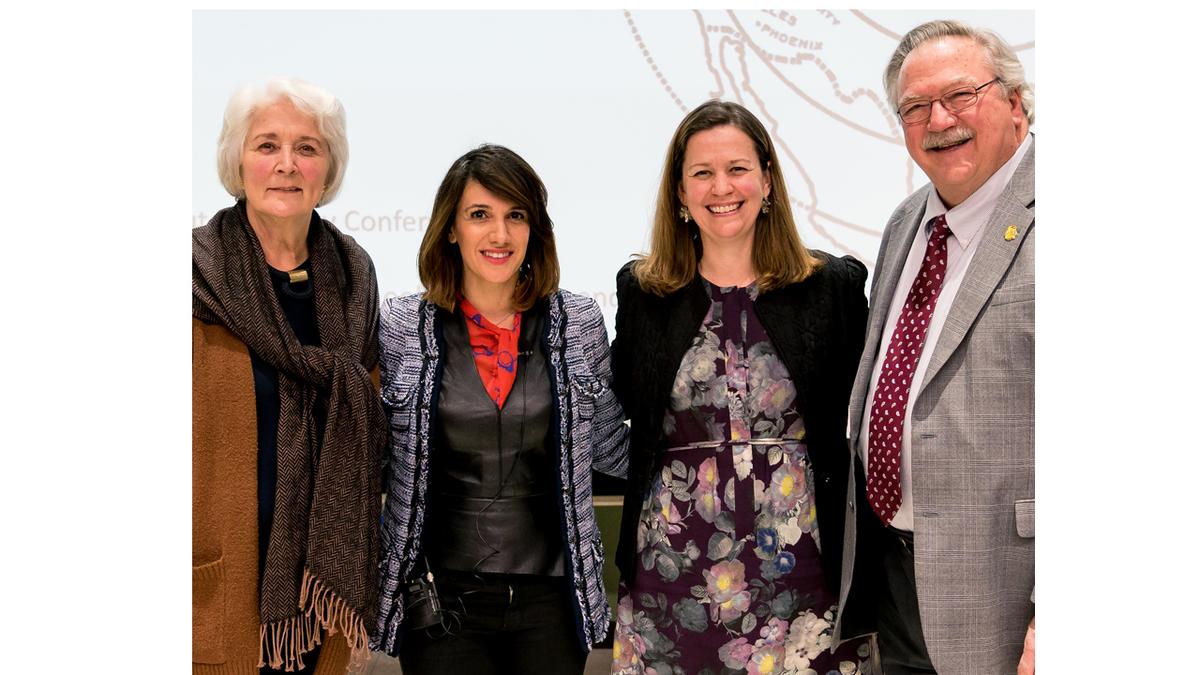This process was the intent of the 2018 Richard Paul Teske Sieur du Lhut Creativity Conference, which brought the two disciplines of business and creativity to the forefront.
The Creativity Conference was borne out of the auspices and generosity of the late UMD alumnus Richard Teske and his wife, Judy. He wanted to provide the resources for his alma mater to bring accomplished people from a wide range of fields to campus, certain that the interaction between students and these guests would inspire and expand the learning process. Teske felt that students needed to be exposed to different opposing viewpoints to help solve the world’s problems.
Judy has continued that legacy. The 2018 event, coordinated by LSBE and the Chancellor’s Office, brought Amy Whitaker and Sura Al-Naimi, experts in combining creativity and business, to campus. Al Naimi’s background of being a “creative sherpa of collaborative human-centered design processes that bring about change” and Whitaker’s insight on “combining the mindsets of art and the tools of business … for success” were spot on for the conference mission.
Al-Naimi and Whitaker engaged with students in a variety of venues throughout the two-day conference, which culminated in their presentation to an audience of approximately 260 people. Here, the audience heard of true success stories of individuals and businesses that mastered meshing creativity and businesses. Relevant and applicable processes to help with being creative in today’s world were provided by both speakers.
Whitaker presented the story of the neurologist, Roger Bannister, who, as an amateur runner, didn’t give up the dream of breaking the world record for the mile run. He persevered for two years, while still in residency—training in his spare time. In 1954, he broke the record.
Whitaker explained that while people see the creative process as going from Point A to Point B, creators are actually inventing Point B.
Her process for being creative consisted of:
- Defining a grace period
- Setting aside studio time
- Finding your lighthouse question
- Thinking in portfolios
- Owning a part of what you create
Finally, Whitaker provided the scenario of looking out as far as you can see and then getting to that spot. However, once you get to that spot, again look out as far as you can see and go. Repeat that process over and over.
Al-Naimi began by explaining that her first name, Sura, means chapter as well as walking in the desert at night. She felt that her life is a journey and she is an explorer, “putting one foot in front of the other, not knowing what you’ll find.” We all can be explorers and map makers with some changes in our thinking, she said.
Change is perpetual, Al-Naimi explained. In 2017, only 60 Fortune 500 firms remained that were viable in 1955. But new companies have emerged: Netflix, AirbnB, Apple, Amazon and more. They did not kill their industries/markets but rather changed them with creative spins on the basic business format.
These companies shifted their relationship with creativity; a process, Al-Naimi said, we can all benefit from.
Creativity is the habit of doing things in new ways to make a positive difference to our working and personal lives, said Al-Naimi. We have to structure it and put it on our calendars.
Her process for creativity was the following:
- Unlearn and challenge what we know.
See things with fresh eyes (turn something upside down for a new perspective)
- Break the rules
List all the rules that define your project. Then choose one and break it somehow (eliminate, grow it, etc.) Ask – How would the world look if that broken rule was in existence? What would change?
Example: In the late 1980s/early 1990s, the only way to get a digital movie to watch at home was to rent one from a store like Blockbuster. But in 1998, the creator of Netflix thought, why can’t movies come to people? And Netflix was born as the first mail-order movie rental company.
- Create a bridge
Between the horse and carriage and motor vehicle stages of transportation came the horseless carriage.
- (People might think you’re crazy, so) find a team of like-minded individuals.
- Find the secret sauce – secret ingredient. What makes your idea different?
And remember, you will feel both fear and excitement as you combine creativity with business.
Photo above: Judy Teske, Sura Al-Naimi, Amy Whitaker, Chancellor Black
